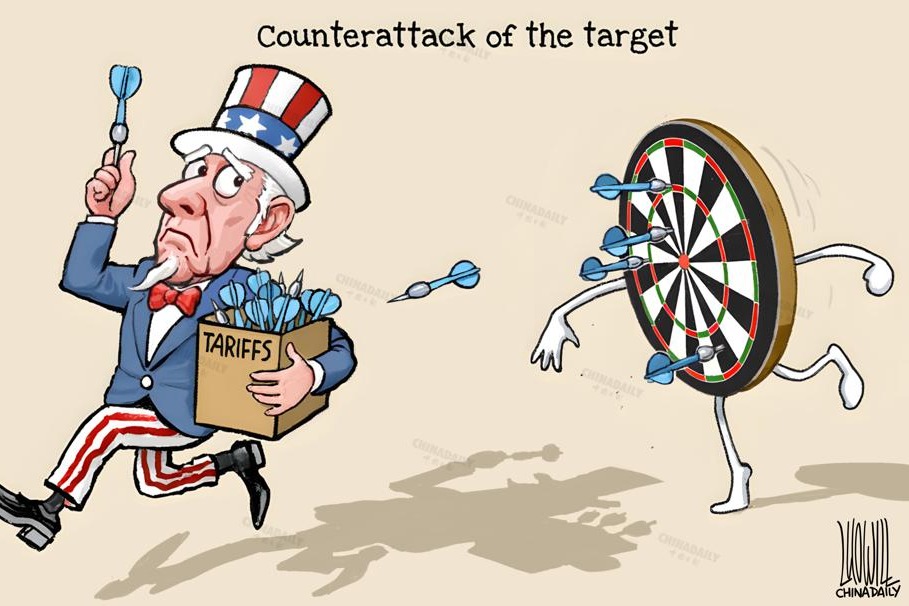How to realize the 5.5% growth target


Editor's Note: The government has set the economic growth target for this year at 5.5 percent. Three economists discuss the paths of China meeting this "relatively ambitious" target.
Strong policy support needed to meet goal
The Chinese government has set a 5.5 percent GDP growth target for 2022, which is higher than what we (at Deutsche Bank) expected. But we consider this a positive policy surprise, which will pave the way for stronger policy support.
The government's budget implies a 2.5 percent of GDP increase in total fiscal deficit, which is again much higher than our forecast of a 1.5 percent of GDP increase. As such, fiscal efforts will be focused on tax cuts and investment in energy, transportation, and city infrastructure upgrading, while energy consumption controls will be made more flexible.
Achieving 5.5 percent growth requires strong policy efforts in order to sharply accelerate the near-term growth momentum. Assuming that the first quarter growth stays at 4-4.5 percent, China needs to reach 5.8 percent growth on average in the next three quarters to realize 5.5 percent growth for the whole year.
The fiscal stimulus is equivalent to 2.5 percent of GDP funded by carryovers and special contributions from State-owned entities, with the government not planning to increase bond issuances. In fact, the government's general bonds quota has been reduced from 3.57 trillion yuan ($564.82 billion) last year to 3.37 trillion yuan this year, while the local government special bonds quota remains unchanged at 3.65 trillion yuan.
As for fiscal efforts, they will be focused on targeted tax cuts and public investment. For example, the government may further reduce value-added tax and income tax on small and micro-sized enterprises, and increase tax deductions and refunds for companies in manufacturing, environment, power and transport sectors, as well as for corporate spending on research and development.
Moreover, the areas of focus for public investments include water conservancy projects, transportation networks, energy bases and facilities, renovation of urban gas and other pipelines, and improvement of flood control and drainage facilities, as well as increased investment in community eldercare and childcare facilities.
To boost consumption, the government will continue to support new energy vehicle purchases, and support the rollout of green and smart home appliances in rural areas.
Also, the government is likely to be more flexible on annual energy consumption targets, and will not include new renewable energy supply in the total energy consumption target. And aside from building larger solar and wind power plants, the government will also accelerate the greener renovation and upgrading of existing coal power plants and heating systems, and push for metals, chemicals and building materials industries to become more efficient and meet its green goals.

Growth to return amid credit and fiscal impulse
China's GDP growth target for this year is above the market consensus forecast, which was slightly below 5 percent. The gap reflects the contrast between the firm pro-growth stance versus soft data and weakening business sentiment. We (at Morgan Stanley) are more in the glass half full camp, expecting the return of credit and fiscal impulse, calibration of regulatory reset and fine-tuning of the dynamic zero-infection policy to drive an above-consensus recovery from the second quarter onward.
The fiscal deficit target set by the National People's Congress may look unexciting, but reading below the surface, we see a fiscal impulse supported by disposal of leftover funds. The fiscal carryover amounts to more or less 2 percent of GDP in this year's general budget to fund a meaningful fiscal easing package and transfers to local governments, as land revenues may fall short.
This combined with 1.2 trillion yuan ($189.82 billion) in local government special bonds leftover proceeds means fiscal policy will be more proactive than headlines suggest. We expect the augmented fiscal deficit to expand by 2 percentage points of GDP, following a meaningful consolidation last year.
What's in the fiscal easing package besides infrastructure?
The sizeable tax and fee cuts are expected, including VAT refund for manufacturers, business tax cuts for services sectors, and further deductions on R&D spending.
As far as housing policy is concerned, the Government Work Report has a balanced tone. It says "houses are for living in, not for speculation" and the government will support the "commodity housing market in better meeting the reasonable needs of homebuyers".
Against the backdrop that a dozen or so cities have relaxed home purchase restrictions since mid-January, this balanced tone could give more cities the flexibility to tweak home purchase policies after the NPC session. Amid such local relaxation and accelerating disbursement of development loans, we expect year-on-year growth of housing investment and sales to turn marginally positive in the third quarter on a low base.

GDP target achievable with policies and efforts
The Government Work Report, which Premier Li Keqiang submitted to the NPC on Saturday, set China's 2022 GDP growth target at 5.5 percent, which is consistent with our (Standard Chartered Bank's) expectation.
The thrust of the Government Work Report is in line with the Central Economic Work Conference's emphasis on stabilizing growth. We think it will take supportive policies and forceful implementation to achieve the ambitious growth target, as China faces shrinking demand, supply shocks and weakening expectation domestically and more complicated and uncertain external environment.
Monetary, fiscal and property policies are set to be eased, in addition to flexible assessment of the energy intensity target and assurance of power supply.
The Premier called for more robust implementation of the prudent monetary policy, asking banks to provide more loans to the real economy with lower effective lending rates. We expect a moderate re-leveraging this year, with total social financing growth of 10-11 percent outpacing our estimated nominal GDP growth of 8-9 percent. We also see a window for a reserve requirement ratio and policy rate cut in March/April.
While the narrowly defined official budget deficit of 2.8 percent of GDP indicates a fiscal tightening in 2022, the broad budget deficit, which includes the revenue-spending gap financed by local special bonds (3.65 trillion yuan) and cash surplus from previous years, suggests a fiscal expansion of 1.7 percent of GDP. We see the fiscal impulse turning positive in 2022 from negative in 2021 if the broad budget deficit is fully implemented. Local officials should have incentive to make good use of the fiscal space available in the budget, given that meeting the growth target this year may be more challenging than last year.
The budget will allow meaningful tax and fee cuts and the ramping up of infrastructure spending. The budget report also suggests only half of the surplus cash from last year was deployed in the 2022 budget, leaving additional fiscal ammunition of 1 percent of GDP that can potentially be drawn upon if necessary.
The government has reiterated the principle of "houses are for living in, not for speculation", but highlighted the need to meet reasonable housing needs and promote the healthy development of the housing market by stabilizing land prices, housing prices and market expectations. We expect a fine-tuning of property policies to ease the real estate sector's drag on investment.
We see moderate upside risk to our 2022 growth forecast of 5.3 percent. Infrastructure investment is expected to pick up significantly, partly offsetting the drag from property investment. Adequate implementation of the budget would be essential for reaping the benefit of a supportive fiscal stance, in our view.
An ambitious GDP target, together with pro-growth measures, should support yuan strength throughout 2022. A step-up and front-loading of supportive measures should lead to a rebound in activity by midyear. China's balance of payments will likely remain strong on resilient exports and continued capital inflows in search for yield and diversification.

The views don't necessarily reflect those of China Daily.
If you have a specific expertise, or would like to share your thought about our stories, then send us your writings at opinion@chinadaily.com.cn, and comment@chinadaily.com.cn.































